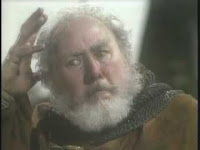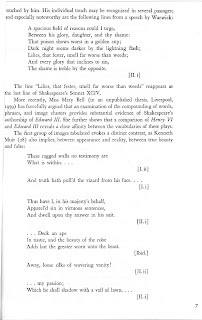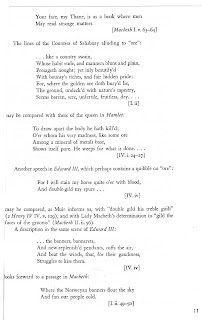 As part of the TSI 2010 first week, tonight we watched the BBC production of 1 Henry IV (1979) with Jon Finch (who also played Macbeth in Roman Polanski’s 1971 film) as Henry IV, David Gwillim as Hal, Anthony Quayle as Falstaff, and Tim Piggott-Smith as Hotspur. The BBC films tend to provoke a fairly tepid response from both critics and students. It’s great to have an available version of each of Shakespeare’s plays, especially those that rarely see time on film, but that benefit is not always followed up by an entertaining or, in some cases, even a completely watchable production.
As part of the TSI 2010 first week, tonight we watched the BBC production of 1 Henry IV (1979) with Jon Finch (who also played Macbeth in Roman Polanski’s 1971 film) as Henry IV, David Gwillim as Hal, Anthony Quayle as Falstaff, and Tim Piggott-Smith as Hotspur. The BBC films tend to provoke a fairly tepid response from both critics and students. It’s great to have an available version of each of Shakespeare’s plays, especially those that rarely see time on film, but that benefit is not always followed up by an entertaining or, in some cases, even a completely watchable production.I remember watching these as a junior high and high school student when they originally aired and being struck by an unfortunate sameness to them. Look at the costumes in Midsummer Night’s Dream (directed by Elijah Moshinsky) and Othello (directed by Jonathan Miller), for example; it’s as if the actors from Act 1, scene 1 of the former walked right into the senate scene of the latter.
After watching a number of these, you should get a pretty clear sense of the BBC’s goal. They wanted to get an archival production committed to video without any directorial flourishes that might have “dated” the production for viewers far into the future. The costumes are distinctly renaissance-y, the character interpretations straightforward, and the direction focused primarily on presenting the language rather than creating a context for the language; it’s museum theater on videotape.
David Giles’ 1 Henry IV, which coasts along on some very strong acting by its principals, particularly Quayle, is among the better productions. But I still felt it had a certain static quality that would give me a little concern if I were showing the entire 155 minutes to a high school class. I don’t mean that it lacks action and fails to satisfy the Braveheart and Gladiator standards for battle violence (that’s apples to oranges), but that Giles, like many of the other BBC Shakespeare directors, hasn’t given the play’s narrative much shape. Competent scenes follows competent scene without much sense of where it’s all going.
Take Quayle’s Falstaff. His scenes with Gwillim through the first part of the play are wonderful and his Falstaff is a man who has settled into his braggadocio and deceits, both of self and others, like comfortable old clothes. There is also a vulnerability about him, which Quayle ties to his age more than his overindulgences, that evokes a fair amount of sympathy no matter what outrageousness he’s perpetrating.
Then, in Act 4, when the play turns to battle scenes, his Falstaff begins rather abruptly to speak directly to the camera. Yes, these are his first scenes alone (4.2, 5.2, 5.3, and 5.4) and his speeches are necessarily monologues, though they tend to be directed to dead bodies. Looking into the camera, though, makes the viewer a participant in the action. It’s as if we’ve replaced Hal as his audience, and Falstaff needs an audience. But breaking the fourth wall here also shifts an arrangement Giles has previously made with the audience, that we are watching these characters in some far off world populated primarily by Shakespeare’s language. Quayle’s looking at the camera is jarring, in part because it shifts our relationship to Falstaff’s character, deviating from both the tone of the production and the direction this Falstaff has established.
One could argue that such a shift is appropriate because, as Gail Kern Paster suggested earlier this week, Falstaff’s actions during the battle have consequences in the way that his shenanigans in Eastcheap do not. But how does breaking the fourth wall amplify this? How does the winking “you’re in on this” involvement of audience bring the character to some logical conclusion in this production? The Falstaff who looks at us knows himself more completely, knows his villainy and shortcomings more casually, lacks our sympathy, betrays more of a calculating nature. The choice may serve to best present the speeches he’s making in the play’s latter part, but it disconnects Falstaff a bit from the character established prior.
I was also struck by another aspect to the BBC’s museum theater approach that amplifies the static feeling of their productions. The films are what Shakespeare-on-film critic Samuel Crowl would refer to as “theatrical,” that is they are films of stage productions. The BBC has removed the literal theatrical stage, but the physical sense of it is still there – the shots are confined to cramped locations, there are no landscapes or depictions of the world without characters (no establishing shots for example), the camera is limited to a theatrical audience’s viewpoint, and nearly all the camera movement (pans, tilts, tracking shots) and perspective (high and low angle, long shots) we associate with movies is absent.
But in a theater there is sound. Not necessarily music or even the constant voices of acting, but the sound of an audience experiencing live theater – laughing, shifting in their seats, gasping, coughing, breathing. The air in a theater is alive, vital. Film cannot capture this organic symbiosis of actor and audience. It replaces it, in fact, with relentless soundtrack noise – orchestrated music that swells and ebbs with the story’s emotional fluctuations, life sounds associated with the setting, popular music inserted into the narrative. When you watch the BBC productions, what you get is an absence of both. Essentially you get the actors speaking their lines into dead air. It’s disconcerting and, for me, it has the effect of sucking a lot of life out of some of the most beautiful poetry ever put to action.
The medium does make a difference. And that’s something I think the BBC Shakespeare never understood.
Randall
photo credit: Anthony Quayle as Falstaff in the BBC Shakespeare's Henry IV, Part 1.










